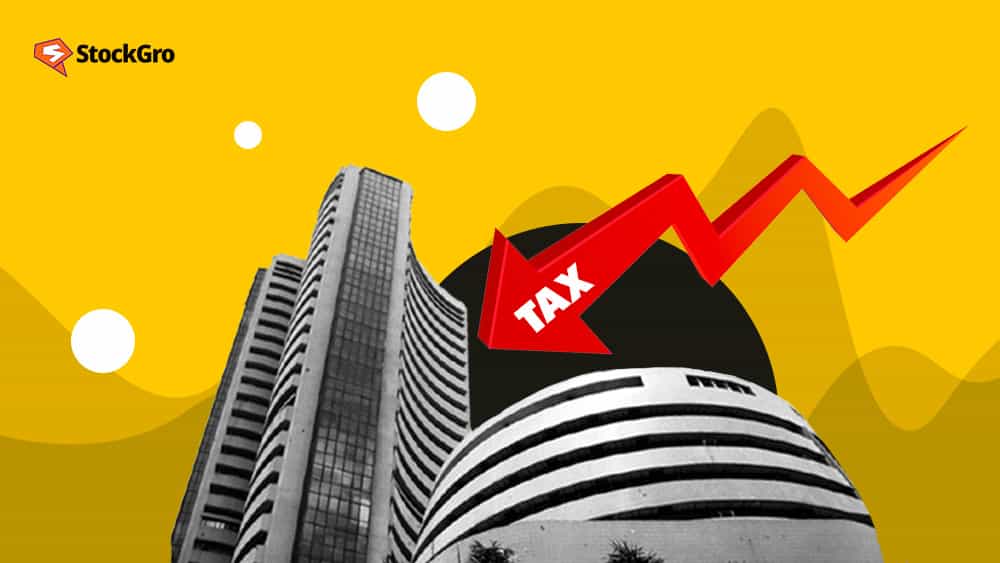
Despite the rollercoaster ride of the pandemic, the Indian equity markets have been a beacon of hope for investors. Yet, with great returns come great tax responsibilities. The exact amount of tax levied on your gains depends on a myriad of factors – the type of gains (short-term or long-term), the tax bracket you fall into, and any recent changes in tax laws.
Investing in the stock market can be thrilling, especially when your investments grow. Before you start counting your profits, have you considered the taxes that come with it? That’s right, the taxman always wants a piece of the pie.
So, let’s dive into the world of taxes and unravel the mysteries of how gains from the stock market are taxed in India.
Capital Gains
Under the Income Tax Act of 1961, gains from the sale of shares fall under the head ‘Capital Gains.’ Capital gains are further classified into two categories:
1. Short-term Capital Gains (STCG)
If you sell your shares listed on a stock exchange within 12 months of purchasing them, you might end up with short-term capital gains or losses.
The calculation is simple: ( sale price – expenses on sale – purchase price). If you make a profit, you’ll have to pay tax.
But how much tax, you ask? Short-term capital gains are taxable at a rate of 15%.
Let’s take a real-life example to understand this better. Imagine our friend Kuldeep Singh, who bought 250 shares of a publicly traded firm for Rs. 38,750 at Rs. 155 per share back in October 2015. After five months, he sold them for Rs. 192 per share, making a total of Rs. 48,000. Let’s crunch the numbers and see how much he owes in taxes.
Full sales value: Rs. 48,000
Brokerage at 0.5%: Rs. 240
Purchase price: Rs. 38,750
So, Kuldeep’s short-term capital gain would be Rs. 48,000 – (Rs. 38,750 + Rs. 240) = Rs. 9,010. But remember, 15% of this amount will go towards taxes.
And remember, regardless of your tax slab rate (10%, 20%, or even 30%), the tax on short-term capital gains remains at a special rate of 15%
2. Long-term Capital Gains (LTCG)
Now, let’s say you hold on to your shares for more than 12 months before selling them. In that case, you’ll deal with long-term capital gains or losses. The good news is that these gains used to be tax-free until the Budget of 2018 showed up with its own set of rules.
As per the new regulations, if your long-term capital gains exceed Rs. 1 lakh from the sale of equity shares or equity-oriented mutual fund units, you’ll have to pay a 10% tax (plus applicable cess). The benefit of indexation (more on this later) is not available in this scenario.
You may also like: Tax saving scheme in India 2023 [Explained]
Grandfathering clause: A twist in the tale
The government introduced a “grandfathering rule” for gains starting from 1st February 2018. What’s that, you ask? Well, any long-term gains from equity instruments purchased before 31st January 2018 will be calculated according to this rule. So, if you fall into this category, you’ll be taxed accordingly.
To calculate the acquisition cost for the grandfathering clause, you need to consider the fair market value (FMV) as of January 31, 2018, or the actual selling price, whichever is lower.
FMV, or the actual purchase price, whichever is higher, is used to calculate the long-term capital gain. And here’s the sweet part: you get a tax-free exemption of Rs. 1 lakh on your long-term capital gains. Beyond that, you’ll be taxed at 10%, plus the applicable surcharge and cess.
Let’s take another example to make things crystal clear. Meet our friend Ramesh Kapoor, who bought 500 shares of a company back in December 2017 for Rs. 62,500 at Rs. 125 per share. Fast forward to 2023, and he decides to sell them for Rs. 280 per share, making a total of Rs. 1,40,000. Get ready for some number crunching!
Full sales value: Rs. 1,40,000
Brokerage at 0.5%: Rs. 700
Purchase price: Rs. 62,500
Here comes the twist: Ramesh’s long-term capital gain will be calculated based on the “grandfathering rule.” Let’s say the fair market value of each share on January 31, 2018, was Rs. 200. We’ll calculate the capital gain using this value.
Purchase price (adjusted): Rs. 62,500 * (200/125) = Rs. 1,00,000
So, Ramesh’s long-term capital gain would be: Rs. 1,40,000 – (Rs. 1,00,000 + Rs. 700) = Rs. 38,300.
And guess what? He’ll have to pay a 10% tax on this amount (plus cess). But hey, at least he got the benefit of the grandfathering rule!
Loss from equity shares
So, you’ve had a not-so-lucky run with your equity shares. Don’t worry, there’s a silver lining even in the world of losses. Let’s dig into the details of short-term capital loss (STCL) and long-term capital loss (LTCL) from equity shares and how they can impact your tax liabilities.
Short-Term Capital Loss (STCL)
If you’ve incurred a loss from selling equity shares within a year of purchase, you’ve got yourself a short-term capital loss (STCL). But don’t despair just yet! This loss can be offset against any short-term or long-term capital gains you make from any capital asset.
If the loss isn’t fully offset, you can carry it forward for eight years and use it to adjust against any capital gains during that period.
But here’s the catch: to carry forward these losses, you must file your income tax return within the due date. Even if your total income for the year is below the taxable limit, filing your tax return is a must to preserve those losses for future use.
So, ensure you stay on the right side of the taxman by filing your returns on time.
Also Read: What is demat account: All you need to know?
Long-Term Capital Loss (LTCL)
Until the Budget of 2018, long-term capital losses from equity shares were considered a dead end. They couldn’t be adjusted or carried forward because long-term capital gains from listed equity shares were tax-exempt. But the tides have turned.
With the Budget of 2018, the government introduced a 10% tax on long-term capital gains exceeding Rs. 1 lakh. And guess what? They also allowed losses from listed equity shares and mutual funds to be carried forward. So, your long-term capital losses can now find a new lease on life.
You can set off your long-term capital losses against any other long-term capital gains. But remember, you can’t set off long-term capital losses against short-term capital gains.
Any unabsorbed long-term capital loss can be carried forward for up to eight years to set off against long-term gains in the future. To make use of this opportunity, make sure to file your tax return within the due date.
Indexation benefit
Inflation eats away the value of money over time and can lead to higher tax liabilities on long-term capital gains. But Indexation benefit comes to the rescue.
Indexation is a technique used to adjust the purchase price of an asset for inflation. By factoring in inflation, the indexed cost of the asset increases, which can reduce your taxable gains.
However, note that indexation’s benefit for calculating long-term capital gains on debt mutual funds has been eliminated for investments made on or after April 1, 2023.
Let’s say you bought a bond for Rs. 10,000 in 2010 and sold it in 2022 for Rs. 15,000. Without considering inflation, your capital gain would be Rs. 5,000.
But if we apply an inflation rate of 5% for that period, the indexed cost of the bond would be Rs. 13,440, resulting in a capital gain of Rs. 1,560. The tax on this capital gain would be 10%, amounting to Rs. 156.
A peek into the taxing world of different types of equity shares
| Type of Equity Share | Holding Period | Type of Capital Gain | Tax Rate |
| Listed Domestic Shares | Up to 12 months | STCG | 15% |
| More than 12 months | LTCG | 10% on cumulative LTCG exceeding Rs. 1 lakh in a Financial Year | |
| Unlisted Domestic Shares | Up to 24 months | STCG | As per the Income Tax slab rate of the investor |
| More than 24 months | LTCG | 20% with indexation |
Mutual fund taxation
Mutual funds, the popular choice for many investors, also have their own set of tax rules. Let’s uncover the tax implications for different types of mutual funds:
Equity Mutual Funds
If you hold equity mutual fund units for 12 months or less, you’ll be dealing with STCG tax at a rate of 15%. But if your holding period exceeds 12 months, the magic of LTCG tax takes over. You’ll pay a 10% tax on cumulative capital gains exceeding Rs. 1 lakh in a financial year.
Debt Mutual Funds
For debt mutual funds, the holding period matters. If you redeem units within 3 years of holding, you’ll be dealing with STCG tax as per your income tax slab rate.
But if you hold on for more than 3 years, LTCG tax enters the scene. You’ll pay 20% tax with indexation. Remember that the earlier provision of opting for LTCG tax at 10% without indexation is no longer available for units sold after July 10, 2014.
Also Read: Margin trading: Exploring the risks and rewards
Exchange-traded funds
ETFs, those versatile investments traded on stock exchanges, follow tax rules that are as diverse as the ETF universe itself:
- Index and Sectoral ETFs: These ETFs track indices or specific sectors. For tax purposes, they are treated like equity-oriented investments. Hold them for over 12 months, and you’ll face LTCG tax at 10% on aggregate gains exceeding Rs. 1 lakh in a financial year. STCG tax at 15% applies for a holding period shorter than 12 months.
- Gold and International ETFs: Gold and international ETFs align with debt mutual funds for taxation. For a holding period of less than 36 months, STCG tax follows your income tax slab rate. If your investment is held for more than 36 months, you will be subject to an LTCG tax of 20% with indexation.
Are you ready to harness the power of tax-savvy investing? With the right strategies and a keen eye on tax implications, you can maximize your gains and minimize your tax burden. So, why not confidently embark on this journey and take control of your financial destiny?

